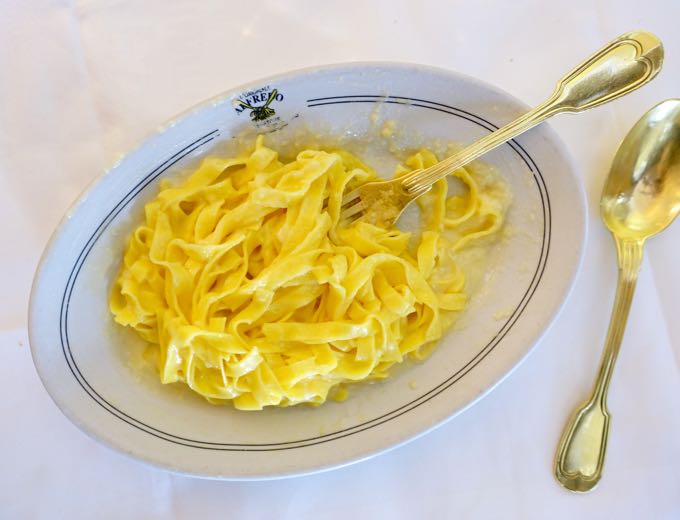
I have a huge fondness for old fashioned restaurants with a story behind them. And when that story involves a lot of butter and cheese? Even better.
There are certain, extremely unfashionable, dishes that I’m continually drawn to. I know I can’t eat them every day, but, for instance, when I find myself at Pompiere I often eschew their excellent Amatriciana or Carbonara in favor of the cream-drenched Fettucine al Limone. Similarly I go straight for the Taglierini al Paoli at Paoli in Florence. Full of ham, peas and cream it couldn’t be more 1950’s if it tried.
And then there is the king of 20th century pasta dishes that sort of symbolizes this kind of cooking. I’m talking about the kind of Italian cooking that dates from a time when chefs in Italy were trying to go beyond cucina rustica with its tomatoes, pancetta and olive oil to embrace signs of wealth like butter, cheese and cream. I’m talking about Fettuccine Alfredo.
I know what that at least 85% of you are now thinking. “ Wait! Isn’t Fettuccine Alfredo an American invention”? No. Most definitely not. Fettuccine Alfredo was invented in the most romantic way possible by a chef called (you guessed it) – Alfredo, for his wife, in Rome.
Alfredo, who was 100% Roman from Trastevere, opened a restaurant in 1908, a small hole-in-the-wall with no name on a small piazza near the Trevi fountain. While he worked hard making a go of the restaurant his wife, Inès, was leading a typically stressed out life which involved having babies. Her loss of appetite and her general lack of energy lead her husband to prepare a special dish for her that would be not only irresistibly delicious, but also full of nourishing calories. The heaping plate of eggy noodles tossed with massive amounts of grated Parmigiano Reggiano and butter was so delicious that his wife not only gobbled it up, but convinced him to start serving it in the trattoria as well. And that is how Fettuccine Alfredo – (along with Alfredo and Ines’s babies)- was born.
The original restaurant no longer exists because the location – Piazza Rosa – was bulldozed during the construction of what is now Galleria Sordi. And so in 1914 Alfredo opened a new restaurant, Alfredo’s, on Via della Scrofa. And it was here that Alfredo’s magical way with a fork and spoon, and his charming table-side service, twirling the strands of pasta into a holy mixture, gained fame.
While many locals, as well as tourists, visited the restaurant to try this famous dish, it was Douglass Fairbanks and Mary Pickford, visiting Rome on their honeymoon in 1927, who lead the avalanche of movie stars and other famous folk, whose photos now line the walls of the restaurant. So enamored were Fairbanks and Pickford with Alfredo’s pasta skills that at the end of their week in Rome they presented him with a special gift: an inscribed solid gold spoon and fork to use to flip the noodles in the style they so deserved.
The restaurant, and Fettuccine Alfredo, continued to thrive, but by 1943 Alfredo was tired of dealing with food shortages and general hardship of the war years, and decided he should retire. He sold the restaurant to his head waiter, whose family today still owns and runs Alfredo alla Scrofa (where they continue the Fettuccine Alfredo tradition as well).
Alfredo however, after a few years of being retired, decided leisure was not his thing, and, in 1950, opened his own place further down the road, in Piazza Agusto Imperatore. Located beneath the arches of the 1930s-designed piazza, this is where Alfredo, and his family, continue to this day to use their engraved golden fork and spoon to twirl pasta, cheese and butter into sublime submission.
While this is the story of Fettuccine Alfredo in Rome, it totally ignores the misuse of the word Alfredo in the rest of the world. Here are some things to know when talking about Fettuccine Alfredo:
- No, Fettuccine Alfredo is not American. (as I’ve just explained)
- Fettuccine Alfredo has just three ingredients: pasta, Parmigiano Reggiano and butter.
- No, Fettuccine Alfredo does not have cream in it. Nor any other extraneous ingredients like peas or ham or god forbid chicken. And don’t get me started on garlic.
- ‘Alfredo’ is not a sauce you can buy in a jar or a flavoring you can add to just about anything. The magic happens when all the ingredients come together in a happy marriage on a plate together with the pasta.
With all this talk lately about #fakenews and #alternativefacts I can’t think of any other pasta dish that has suffered from so much lack of real investigative reporting. I’m pretty sure #fakepasta should be a thing. Somehow, over the years, the word ‘Alfredo’ has been applied to a type of generically creamy and cheesy sauce. It couldn’t have gotten further from the original purity and simplicity of the dish if it tried.
I think I understand how it happened, though. The true Fettuccine Alfredo calls for a LOT of butter and a LOT of Parmigiano Reggiano (aged 16 to 18 months). Both of those ingredients are expensive. Cream, on the other hand, is cheaper, especially in America. And adding all those other extra ingredients? That IS an American thing.
Also, the process of whipping the aforesaid Parmigiano and butter into a creamy consistency takes patience and skill and a very specific technique. Things that are in short supply, I think, at Italian restaurant chains in the States (not naming any names here).
But enough about what Fettuccine Alfredo is not. It’s much more important to know exactly what it is. Luckily I spent a day last week in the kitchen and dining room of Il Vero Alfredo, seeing exactly how it is made.
Ingredients:
Freshly made fettuccine
Unsalted butter, at room temperature
Hand grated Parmigiano Reggiano
Quantities:
Exactly how much, I am told, is the family’s secret. But after observing them in the kitchen, here are the proportions, more or less. In theory it’s for one portion. But it’s a really large portion.
200 grams / 7 ounces of fresh fettuccine
1 stick / 125 grams unsalted butter
3/4 cup freshly grated parmigiano reggiano
Quality:
Butter: Since the butter is going to be one of the main ingredients, this has to be the best you can get. I don’t know what brand they use here (again, secret) but I tasted it on its own and could have continued eating the sweet butter straight from the spoon.
Cheese: Absolutely must be Parmigiano Reggiano. No, you cannot substitute Grana or another type of hard cheese. I mean you could, but it wouldn’t taste at all like it’s supposed to. And the Parmigiano Reggiano must not be too young, nor too old. 16 to 18 months is the perfect age which will result in both the correct flavor as well as being able to melt into the creamy consistency that is essential.
Technique:
While many restaurants use the same pot of water to boil multiple portions of pasta over the course of the evening, with Fettuccine Alfredo you must start off with a fresh pot of boiling water each time. I know this isn’t an issue for the home cook, but I’m pointing this out for those of you may want to try this in the comfort of your own trattoria. Also, the water seemed to be a bit under-salted than usual, which is probably because so much cheese is added to the finished dish.
The plate must be hot hot hot. At Alfredo’s the chef places the serving dish into a simmering pot of water while the pasta cooks.
The butter, which sits in a bowl of room temperature water, is given a good squeeze first, by the chef with his fist.
The parmigiano must be grated by hand, not in a machine. A machine would heat the cheese too much, which would affect the final dish. And the grater should be the old fashioned kind of Italian grater, with the sharp edges that really grates the cheese into tiny crumbs (if you can manage not to grate your knuckles as well). In other words, very very finely grated. I don’t think a microplane would work, since then the cheese would clump. (And is that grater below the most amazing piece of kitchen equipment you’ve ever seen, or what?)
And finally the mixing: The dish is prepared in the kitchen, then finished in the dining room. The ingredients are layered in the following order:
- plate
- butter
- pasta
- pasta cooking water
- and finally grated cheese
At this point is it handed off to the waiter, who carries it into the dining room, along with his fork and spoon. And this is when the magic happens. Over the course of 2 minutes the waiter stirs, twirls, and lifts the pasta up, scraping the sides of the dish and turning it around and around to blend the pasta, pasta water and its starches, the cheese and the butter until it all emulsifies into a rich and creamy sauce that clings to each and every strand of pasta. And when I say creamy, I mean it descriptively, not literally.
There is no cream.
At all.
Ever.
For such a seemingly simple dish, there is a lot of technique. But isn’t that always the way? That’s why I made a video. Enjoy!
And of course, definitely try this at home and definitely let me know how it turns out.
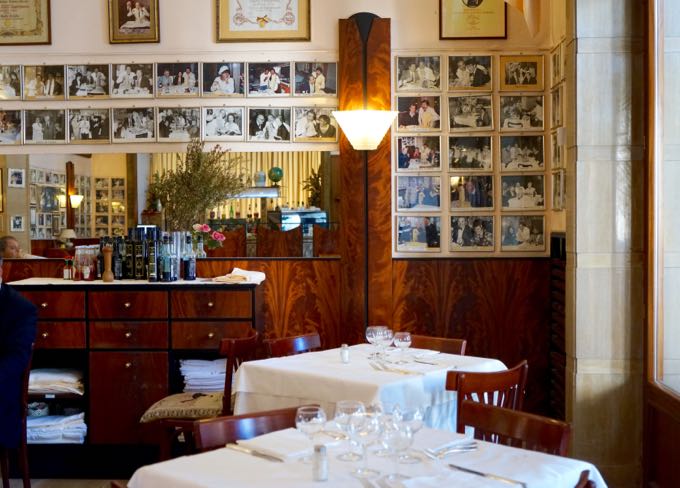
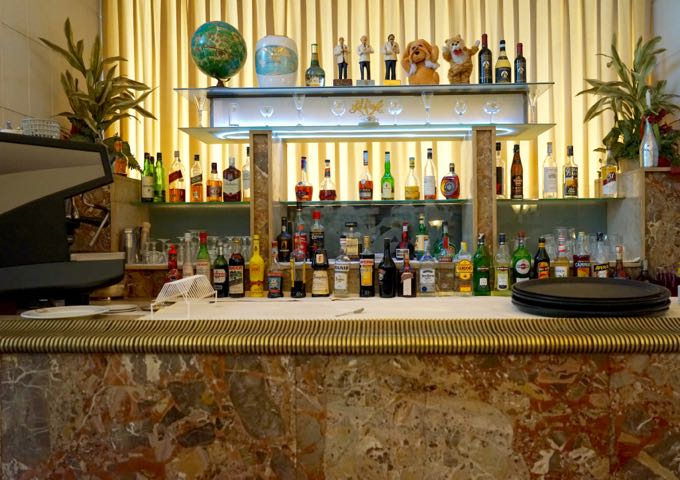
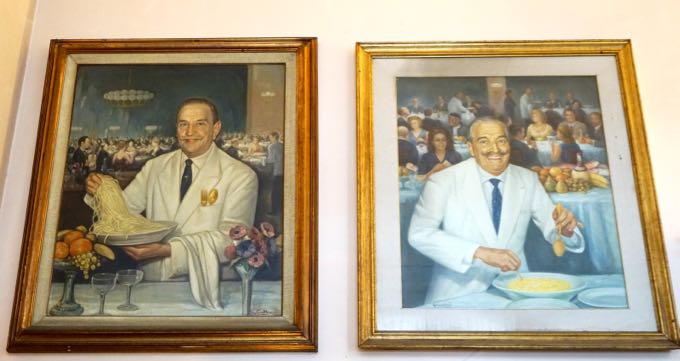
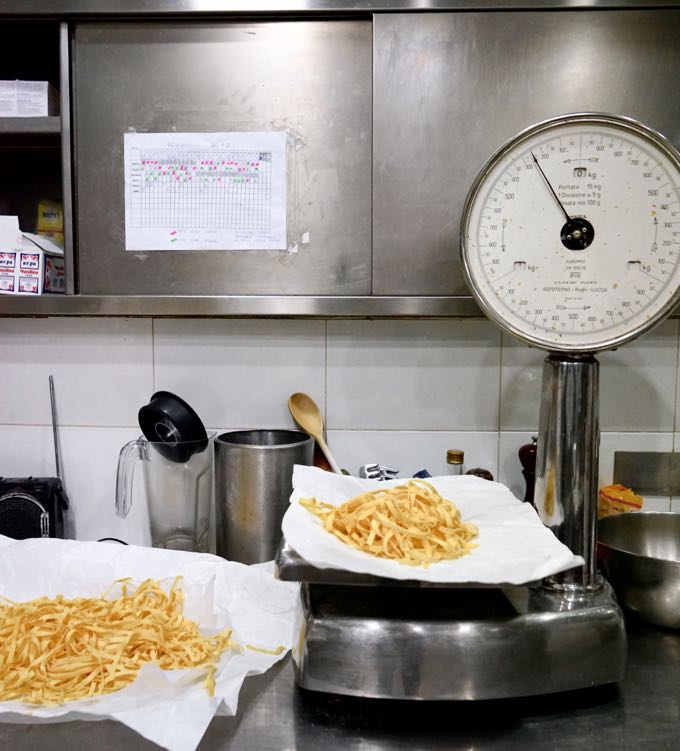
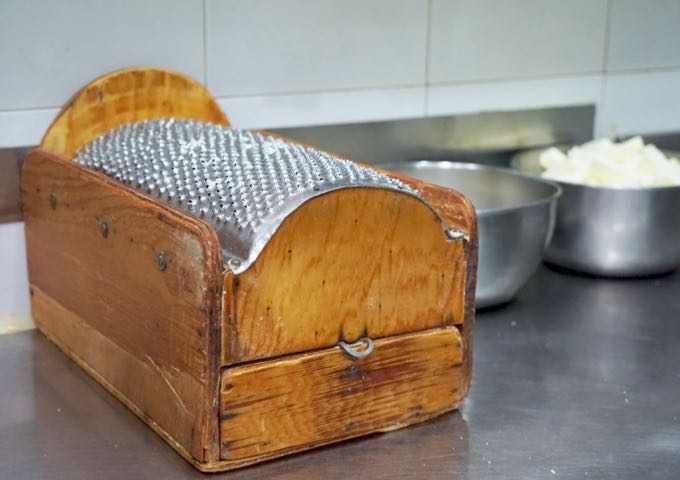
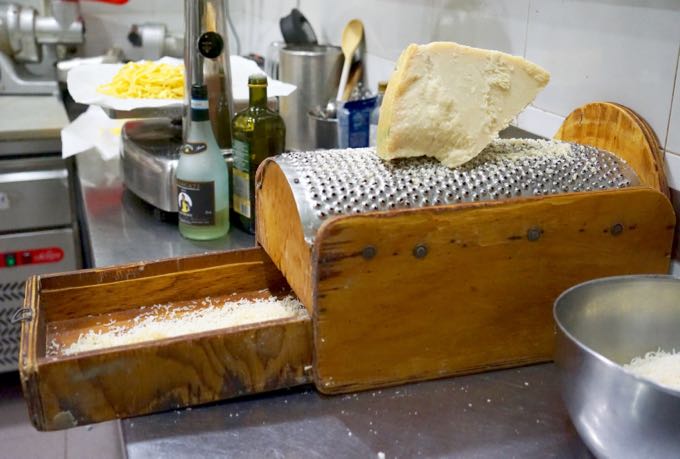
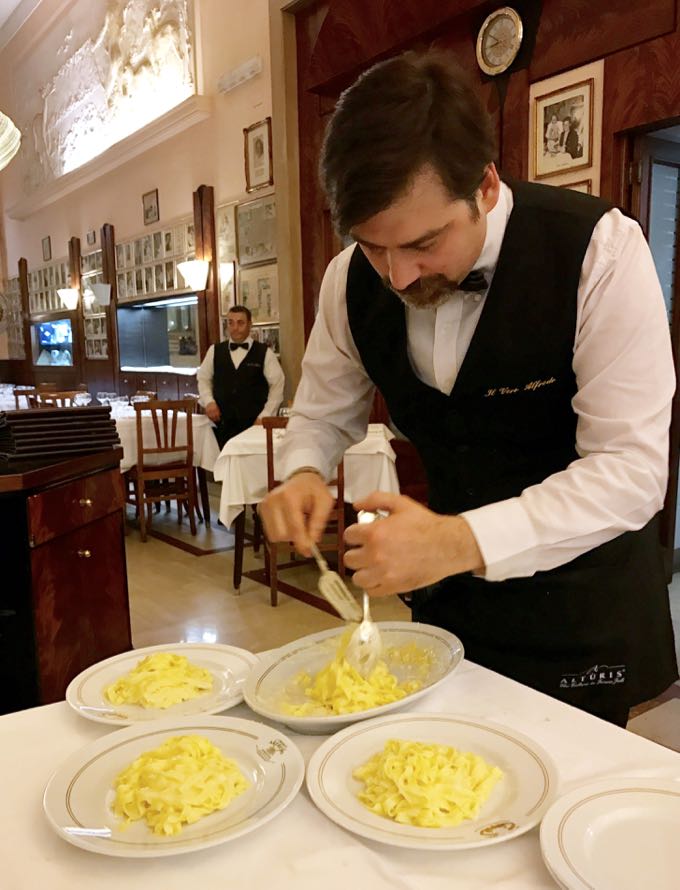
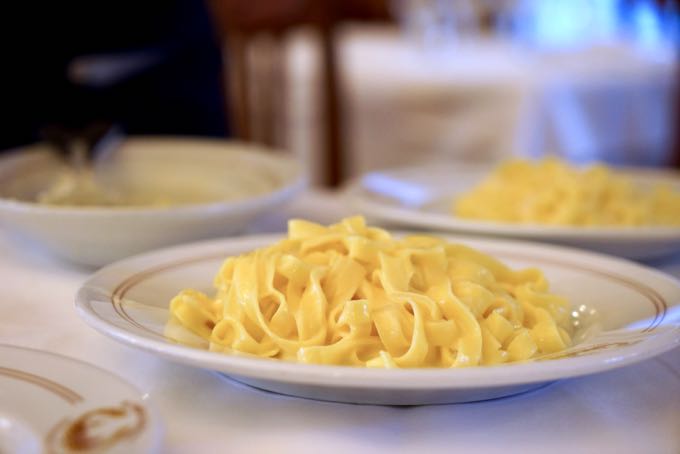
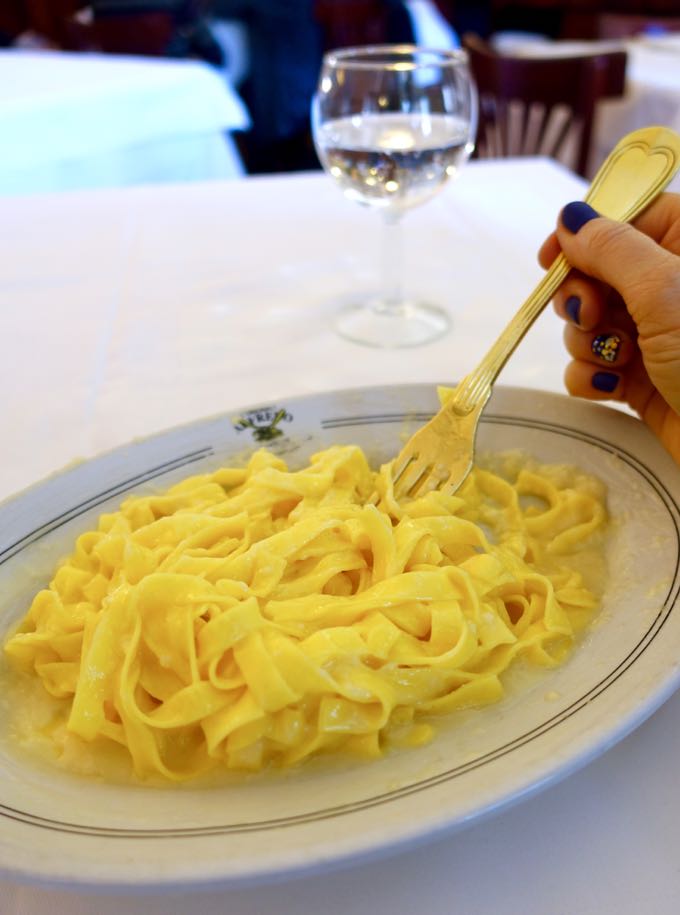
Il Vero Alfredo
Piazza Agusto Imperatore 30
Rome
+39.687.8734
I learned my Alfredo lore from the descendants of the original Alfredo at the above mentioned restaurant. The family of the waiter who bought the restaurant on Via della Scrofa still runs this restaurant and they too serve Fettucine Alfredo according to Alfredo’s original recipe
Alfredo alla Scrofa
Via della Scrofa 104/a
Rome
+39.6880.6163
Be forewarned: both restaurants are pretty touristy. And for a plate of pasta it’s pretty expensive. BUT. You are eating a plateful of history. And if you have a chance to indulge in the original Fettucine Alfredo, while in Rome, then I think that’s well worth it.
The golden fork and spoon: If it looked like I was eating my pasta with a golden fork in the video I was. (it was weirdly heavy!). But that was special just for me. They usually keep it locked up safely. Il Vero Alfredo owns the original set. I’ve heard that Alfredo alla Scrofa had a copy made. But don’t worry, it doesn’t effect the taste one way or another.
For more information on dining in Rome and Italy download my app, EAT ITALY. EAT ITALY is a free app, and contains guides to Venice, Milan, Rome, Florence, Torino and Puglia (and an ever expanding list of regions and cities) available as in-app purchases for both iPhone and iPad.
And don’t forget my book: Eating Rome: Living the Good Life in the Eternal City.
Thank you, Elizabeth! You have just done a great service for mankind.
I live to serve.
OMG….my mouth is watering! Absolutely love watching your videos!
My aim is to make mouths water the world over.
Guess what I’m making for our early dinner today? Thanks for posting, Elizabeth. You’re the best!
Let me know how it turns out!!
a beautiful thing!
Oh my goodness, what a great post! I started reading it, and though I knew Fettuccini Alfredo wasn’t American, I felt reinforced. Then as I read your wonderful historical explanation, I knew there would be a recipe, but then I started praying, “Oh Lord, I hope there’s a video.” And there it was—with that awesome music! Tomorrow, no question, it’s Fettuccini Alfredo for us, with a lot of stirring. Thank you, Elizabeth, your posts are amazing. Ciao!
Thank you!! Let me know how yours turns out!!
Love the video! Now I have to give it a go at home.
lovely— it’s all about the ingredients and technique– the cheese is also different when grated with the old graters! i think the simpliest recipes are always the hardest to replicate.
So true!!
Love this so much. Have visited Alfredo’s on Via dells Scrofa, and wondered about the other! Thanks so much!
Great video. Love to get my hands on one of those cheese graters!
I think you can actually find new versions of them online.
Next time we go to Rome we’ll have to taste for ourselves that wonderful alfredo pasta.
But before then I’m going to make it myself. My mouth is watering already.
Thank you for bringing us such joy.
Cheese + Pasta = Joy.
What a great story. When I was a kid we lived in Rome – this was the mid-50’s. We went regularly – Mom was a beauty and was often presented with the gold spoon – excellent to know that it is still part of the tradition! If I remember correctly at the right time of year you could get truffles grated over the Alfredo. Thanks for the memories and the details – se mangia.
I did not know about the truffles!!!! That sounds too good to be true!!
Che bel video! Grazie.
It looks like the waiter has to do all of the heavy lifting for this recipe. I’m thinking that I should probably wear a hazmat suit when I try the mixing part or I’ll have to shower before sitting down to eat. Even without the cream it’s still a dish on the heavy side so I’d better give this a try while we still have some semblance of winter. Great video!
True. No one ever claimed this was diet food. 😉
My mouth is watering / I am weeping.
What a great post Elizabeth! I’ve read articles written by Italians, stating that this dish isn’t actually Italian but it is! It’s a great story. David Downie’s cookbook on Rome has the true story as well and I’m happy to see someone else get it right. It looks like I’ll have to indulge in that dish at least once in my life. Maybe only once… that’s a lot of butter! I loved the video! That grater is amazing. I have no space in my kitchen, so at least won’t/can’t obsess over it!
Thank you Elizabeth for this wonderful article. It brought back happy memories of the many times I dined at the same Alfredo with my father. We always had that magnificent dish and the same waiter. The last time we were there, we were honored to be allowed to use the gold utensils, which are indeed weirdly heavy, as you noted. We also signed the ledger reserved for those who have used the utensils, I have never had this dish anywhere else where it tastes quite as wonderful…not even close. I will have to try making it at home. Thanks again for the article, photos, and terrific video. It made me want to jump on the next plane to Rome. Ciao!!
So lovely! The lore, the dish, the grater, the butter!
I am confused, though: Marcella has a bit of cream in hers. Certainly nothing else. Fettucine, butter, parm, and only a very little bit of cream, all tossed in the original pasta pot.
Nothing to be confused about. There is no cream in the original. Marcella, and others, may add cream, but the original doesn’t have it.
Okay! I usually take her as the final word but I guess I shouldn’t 🙂
I agree. What a wonderful post! We tried this for dinner tonight and it was wonderful. I definitely have to work on the stirring technique because mine was a little clumpy, but still delicious. And so much better than it is with cream. Thanks again for the post and video. This has gone into our Italy file. One day! And maybe in your apartment if it’s available. By the way, have you moved back home after the redecorating work? How wonderful to have a place to move to get away from the mess.
The clumping may have to do with the age of the parmigiano. To young or too old. Or the stirring….No,we are still camping out. A few more days and hopefully we’ll be back in our beautiful home!
The nowadays forgotten Nobel Prize winner Sinclair Lewis wrote (in “Babbit” as far as I remember) about “a quaint little place called Alfredo’s where they serve the best pasta in the world”. The mention of the restaurant drove many tourists to Via della Scrofa, including Lewis himself many years later. The waiters took pity to the small lonely man, told him that the restaurant was famously mentioned in a book that got the Nobel Prize and asked him if he wanted to write his name in the guest book – which was full of autographs of the famous and mighty. They put the book in front of him and Lewis wrote “John Smith”.
Really? What a lovely story!!!!
looks so delish. glad to have that straight about the origins ;-).
And what is the design on your nail polish?
Thanks! They are little sparkly confetti in honor of Carnevale!
Fantastico!
I made this last night–it was perfect and creamy. You know, I’ve always looked at that odd little side of my box cheese grater with suspicion, never knowing what it was for. But I think using it is the secret to this recipe. Thank you for introducing me to the real alfredo.
Glad it worked out!!!
you know what? I grew up in Rome, my family moved here from Milan almost 40 years ago and I have NEVER, EVER went to Alfredo to try his legendary fettucine..
I just adore the video, your comments are an absolute added value.. what can I say?
Table for 2, Alfredo.. veeery soon!
Thanks for sharing.
Barbara
The final word Elizabeth. When trying to explain Alfredo here, people look at me as if I’m telling them a tall tale! When I read the story of how Alfredo came about years ago, I had to make it when we got a pasta maker and it was, without a doubt a wonderful thing indeed…we actually could not believe it! So, now, of course, I want some! BTW…fettuccine alla limone is pretty darned delicious too! Next time someone questions how Alfredo is made correctly, will send them directly to this great post! You have performed a service to the world!
Glad you liked it!!!
Can’t wait to try this recipe at home and at Il Vero Alfredo when we visit this June! I would love to have your app but I have an android phone. Any chance it will become available for android before June (fingers crossed)?
I made this tonight. I need a lot for practice on the mixing and I think my plate needs to be hotter. But you can really taste what it should be. I will keep practicing.
Fantastic!!! And I can’t think of anything better than ‘practicing’ over and over how to make Fettuccine Alfredo!
MIO DIO!!!
I was planning on making pasta today and doing a bolognese sauce – NOT – I am doing this one!!
Grazie Mille!!
AS an American student studying in Rome in 1978-79 I all too frequently ate the heavenly fettuccine at Ristorante Alfredo. It is a delicious memory. At the time Alfredo II with his signature handlebar mustache was still twirling the golden fork and spoon with his son, Alfredino, starting to take over the restaurant operations. I’m so glad to know the restaurant is still open in Piazza Agosto Imperatore. It’s impossible to explain to fellow Americans that what they know as “Alfredo sauce” is so very foreign from the original. Thanks for your cute video explaining the simple, decadent and delicious treasure that is Le Fettucine Alfredo.
What a great memory! Thanks so much for sharing.
Lordy! That looks divine. I will be making this soon.